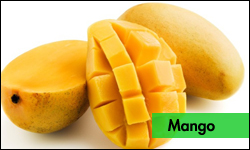Back to > Major Fruits | Minor Fruits | Underutilized Fruits
![]()
 |
||
|
|
||
Nutritional values
Nutritional components:
Because of its attractive appearance and the very pleasant taste of selected cultivars, the mango is claimed to be the most important fruit of the tropics. It has been touted as ‘king of all fruits’ although it has undesirable features including coarse fibrous strands through the flesh and the pungent and turpentine flavors of some cultivars. In addition to income opportunities, the mango is noted for combating nutritional disorders. The mango compares favorably in food value with both temperate and tropical fruits. Indeed the fruit contains almost all the known vitamins and many essential minerals. Studies have shown that one mango fruit can provide a large proportion of the daily human requirements of essential minerals, and vitamins. The calorific value of mango is mostly derived from the sugars. It is as high as that of grapes and even higher than that of apple, pears or peaches. The protein content is generally a little higher than that of other fruits except the avocado. Mangos are also a fairly good source of thiamine and niacin and contain some calcium and iron.
WASTE UTILIZATION:
Mango peel and stone generate waste (40-50% of total fruit weight) and they are rich in various nutrients and many value-added products. Good quality jelly grade pectin (6.1%) and edible fibre (5.4%) could be extracted from ripe mango peel. Acceptable quality vinegar (5.2% acetic acid) and citric acid (20 g / kg peel) could be obtained from mango peel through microbial fermentation. Since, mango kernel contains high amount of fat and starch, the oil extracted from kernel is of good quality and could be used in cosmetic and soap industries. The kernel flour (starch) after mixing with wheat or maize flour can be used in chapaties. About 10% alcohol could be obtained from mango kernel by co-culture fermentation. In food processing industries, enzymes such as cellulase and pectinase from mango peel and amylase from mango kernel can be produced by microbial fermentation. Mango peel can also be used a animal feed despite of its low protein value (3.9 %), but can be enriched to more than five times (20 %) by solid statfermentation using Aspergillus niger. Since it contains lignocellulose, a complete break down is difficult, but co-composting with cowdung in 3:1 ratio results in successful biodegradation.
Reference:
- Diczbalis, Y., Wicks, C. and Landrigan, M. (1997). Heat sums to predict fruit maturity in mango (cv. Kensington Pride). Draft report for HRDC FR605 NTDPI&F.
- Johnson, P.R. and Robinson, D.R. (1997). An evaluation of mango (Mangifera indica L.) cultivars and their commercial suitability for theKimberley. Department of Agriculture. 21/97 ISSN 1326-4168 Agdex 234/34.
- Morton, J. 1987. Mango. p. 221–239. In: Fruits of warm climates. Julia F. Morton,Miami,FL.
- P.R. Johnson and D. Parr. Mango growing in Western Australia. Bulletin 4348
- Maxwell, Lewis S. and Betty M. Maxwell. Florida Fruit. Lewis S. Maxwell, Publisher. 1984. pp. 61-63
- Samson, J. A. Tropical Fruits. 2nd ed. Longman Scientific and Technical. 1986. pp. 216-234.
- Sherrard, J., Johnson, P.R. and Luke, G. (1997). Mango irrigation requirements for the Broome and Ord irrigation areas of Western Australia. Department of Agriculture. Draft report.
- Sites on Mango
- Subtropical/Trop. Fruit Crops Database: http://www.agnic.nal.usda.gov/agdb/stropfc.html
- Mango Produce Facts Linked from the Postharvest Outreach Program, UC Davis
- Mango Overview, Propagation, And Agroforestry Uses Linked from Cornell University
- All About Mangoes
- Mango Fruit Facts and Mango Publications Courtesy of California Rare Fruit Growers.
- Mango Information Linked from NewCrops, Purdue University.
- Mango Tip Burn And Sunburn Images Linked from Texas A & M.
- Mango Production Regions Linked from the Dept. of Agronomy, U.C. Davis
- Mango-Research and Development A site on various aspects related to manoes
- Mango recipes, history, varieties etc — http://freshmangoes.com. or http://freshmangoes.com/mangonews/
- Mango Index Linked Information Mango Produce Facts
- Mango Food Resource (http://osu.orst.edu/food-resource/index.html) Oregon State University, Corvallis
- Postharvest Handling of Pickling Mango
- Mango an introductory description http://www.safari.net/~lychee/mango.htm
- Mangoes – Preparation and nutrition information – Preparation, cooking, and nutritional information for Mangoes
- Mango Botanical Description
- Subtropical/Tropical Fruits Menu University of Florida.
- Subtropical/Tropical Fruit Crops National Agriculture Library, USA
- Market Asia – Technical Information (Postharvest and Market Guides) http://www.marketasia.org/tech
- Mango Mania! is page devoted to the king of fruits http://www.delphis.dm/mango.htm
- http://www.destinationtropicals.com/tropical_plants/plant_43.asp
- http://mangoseedling.com/culturalmgmt.html
